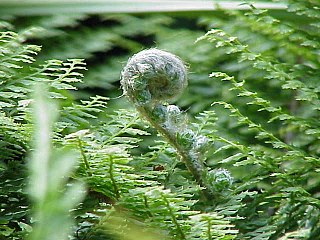
Polystichum is a genus of ferns in the family Dryopteridaceae, subfamily Dryopteridoideae, according to the Pteridophyte Phylogeny Group classification of 2016. The genus has about 500 species and has a cosmopolitan distribution. The highest diversity is in eastern Asia, with about 208 species in China alone; the region from Mexico to Brazil has at least 100 additional species; Africa, North America, and Europe have much lower diversity. Polystichum species are terrestrial or rock-dwelling ferns of warm-temperate and montane-tropical regions. They are often found in disturbed habitats such as road cuts, talus slopes, and stream banks.

Polystichum aculeatum, the hard shield-fern, is an evergreen fern native to Europe. It is most abundant in upland regions of the British Isles and western France, where it benefits from the combination of mild winters and moist summers, but also occurs more locally across most of Europe except northern Scandinavia, northern Russia; in the Mediterranean region it is confined to high altitudes. It grows on steep slopes in woodlands. it is sometimes considered an indicator of the presence of ancient woodlands.

Polystichum acrostichoides, commonly denominated Christmas fern, is a perennial, evergreen fern native to eastern North America, from Nova Scotia west to Minnesota and south to Florida and eastern Texas. It is one of the most common ferns in eastern North America, being found in moist and shady habitats in woodlands, stream banks and rocky slopes. The common name derives from the evergreen fronds, which are often still green at Christmas.
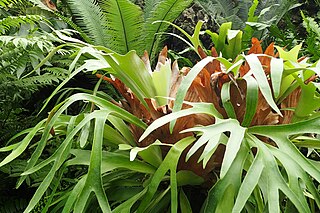
Platycerium bifurcatum, the elkhorn fern or common staghorn fern, is a species of fern native to Java, New Guinea and eastern Australia, in New South Wales, Queensland and on Lord Howe Island. It is a bracket epiphyte occurring in and near rainforests. Growing to 90 cm (35 in) tall by 80 cm (31 in) broad, it has heart-shaped sterile fronds 12–45 cm (5–18 in) long, and arching grey-green fertile fronds which are forked and strap-shaped, and grow up to 90 cm (35 in) long.

Dendrobium moorei, commonly known as the drooping cane orchid, is a species of epiphytic or lithophytic orchid in the family Orchidaceae and is endemic to Lord Howe Island. It has cylindrical pseudobulbs, leathery, dark green leaves and between two and fifteen small, white drooping flowers that do not open widely.

Hymenophyllum moorei is a rare species of filmy fern in the family Hymenophyllaceae. It is endemic to the high cloud forest at Mount Gower and Mount Lidgbird at Lord Howe Island. A small epiphytic fern found usually on tree trunks and fallen logs.
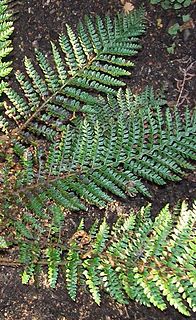
Polystichum proliferum, commonly known as mother shield fern is an Australian endemic fern. The genus name Polystichum is derived from Greek poly - many, and stichos - rows referring to the many rows of sori. The species name is derived from Latin, Proli – offspring and fer - bearing referring to the proliferous buds, a prominent feature of the species.
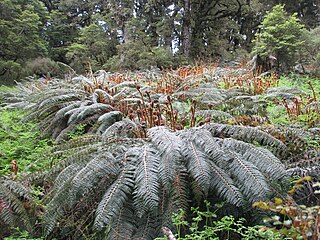
Polystichum vestitum, commonly known as the prickly shield fern or pūnui (Maori), is a hardy, evergreen or semi-evergreen ground fern.
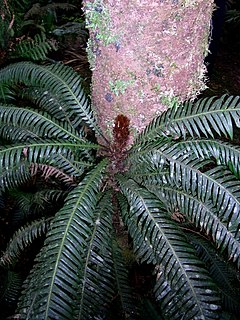
Lomaridium contiguum, synonym Blechnum contiguum, is a fern in the family Blechnaceae. The specific epithet refers to the contiguous lobes of the fronds.

Cranfillia fullagari, synonym Blechnum fullagarii, is a fern in the family Blechnaceae. The specific epithet honours James Fullagar, who collected plants on Lord Howe Island for the Royal Botanic Gardens, Melbourne.
Cranfillia geniculata, synonym Blechnum geniculatum, is a fern in the family Blechnaceae. The specific epithet refers to the geniculate base of the sterile fronds.

Parablechnum howeanum, synonym Blechnum howeanum, is a fern in the family Blechnaceae. The specific epithet refers to the locality to which it is endemic.

Alsophila ferdinandii, synonym Cyathea macarthurii, is a fern in the family Cyatheaceae.

Lastreopsis nephrodioides is a fern in the family Dryopteridaceae. The specific epithet refers to its resemblance to Nephrodium decompositum R.Br..

Polystichum whiteleggei is a fern in the family Dryopteridaceae. A former common name was heavy fern, alluding to the weight of one of the large, thick textured, fronds when fully developed. The specific epithet honours Thomas Whitelegge (1850–1927) of the Australian Museum, who collected zoological specimens on Lord Howe Island in 1887, who first noticed the fern's distinctiveness.
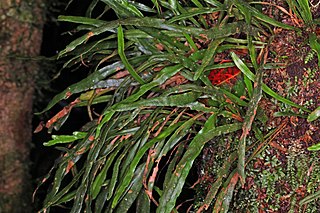
Grammitis diminuta is a fern in the family Polypodiaceae. The Latin specific epithet diminuta means "decreased" or "diminished", with reference to the tapered frond base.

Grammitis nudicarpa is a fern in the family Polypodiaceae.
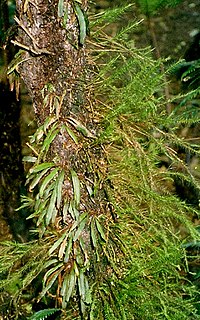
Grammitis wattsii is a fern in the family Polypodiaceae. The specific epithet honours the Reverend W. W. Watts (1856–1920), a prominent Australian cryptogamist active in the late 19th and early 20th centuries.
Callistopteris bauerianum, known as the large filmy fern and Bauer's bristle fern, is a fern in the family Hymenophyllaceae. The specific epithet honours the Austrian botanical artist, Frederick Lucas Bauer (1760–1826), who collected plants on Norfolk Island in 1804–1805.

Leptopteris moorei is a fern in the family Osmundaceae. The specific epithet honours Charles Moore, Director of the Royal Botanic Gardens in Sydney from 1849 to 1896, who collected plants on Lord Howe Island in 1869.


















